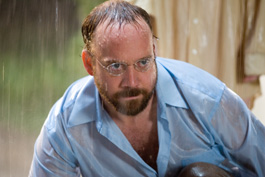home | metro silicon valley index | movies | current reviews | review

Photograph by Frank Masi
Night Moves: Paul Giamatti takes a bath in order to star in M. Night Shyamalan's career-busting 'Lady in the Water.'
Waterworld
M. Night Shyamalan's 'Lady in the Water' is 'The Killer Shrews' for the 21st century
By Richard von Busack
THE STUTTERING HEART of a Philadelphia high-rise is humble handyman Cleveland Heep (Paul Giamatti), who lives in a weed-shrouded bungalow at the tower's feet. He repairs the plumbing, replaces the light bulbs and tends the swimming pool. One evening, a naked and wounded water nymph called Story (Bryce Dallas Howard, pale, strawberry blonde, suitably pre-Raphaelite) materializes from the pool, needing aid to get back to her world.
A bedtime story for undiscriminating children, stripped of all Freudian interest in the pursuit of a PG-13 audience, Lady in the Water may be M. Night Shyamalan's most personal film, as well as his worst. The characters seem to realize that they are characters in a fable, and that they have to figure out the rules of the enchantments. It's as much a game as a film, and it made me grateful for the economical way Monster House stated its rules through a monologue with a video-game wizard (the line was something like "During my travels to comic-book and gaming conventions, I've seen many strange things ...").
Shyamalan is creating his own mythology, and he has terrible trouble loading it into the film. The legend is supposed to be Asian, and it's brought in piece by piece by a squawking, ornery Korean mother through the interpretation of her English-speaking night-life-loving daughter (Cindy Cheung). If this be stereotyping, there's more of it. As in a Frank Capra film, the apartment building is full of encapsulated ethnic types who don't really rub shoulders.
It turns out that the nymph, called a "narf," is being pursued by mystical hyenas ("scrunts") who live in the grass. These shaggy, toothy creatures revive memories of The Killer Shrews (1959). The hellhounds must be held in check until an enchanted eagle can airlift our narf back to her world. So take her, already, since Howard's narf doesn't get to do much except blink wide blue eyes that make Elijah Wood look squinty. She is recuperating, again and again, and Heep's interest is only paternal, despite his tragic backstory. (It's a moldy one, even by Shyamalan standards.) The narf's only purpose in our sphere is to deliver an oracle to a struggling writer, played by Shyamalan himself. But she is hampered in her mission not just by the devil-dogs but also by the building's newest tenant, a bitter, sober-sided film critic named Farber—as in Manny?—Bob Balaban, who hates all stories and believes there's nothing new under the sun.
From the way the director treats the critic, let us guess that Shyamalan is trying to tell us something about the public reception of The Village. Let us also guess that Shyamalan is expressing how his sense of purpose has suffered, and how he dreams of rescue by an angelic muse. I sympathize with the man's hurt feelings, but I love fantasy, and I'm so very weary of trying to suspend disbelief in the service of yet another one of M. Night's trumped-up, rickety plots. Only a superb visual artist could make this mess intoxicating. Despite the service of Christopher Boyle (the ace photographer of watery, humid cities), the camerawork is at a career low. If he's truly looking for a muse, Shyamalan is in a position to find original writers—hundreds of novelists and short-story writers—whom he could adapt in aid of his career-long mission to counter urban horror with healing fantasy.
![]() Lady in the Water (PG-13; 110 min.), directed and written by M. Night Shyamalan, photographed by Christopher Doyle and starring Paul Giamatti and Bryce Dallas Howard, opens July 21.
Lady in the Water (PG-13; 110 min.), directed and written by M. Night Shyamalan, photographed by Christopher Doyle and starring Paul Giamatti and Bryce Dallas Howard, opens July 21.
Send a letter to the editor about this story.
|
|
|
|
|
|